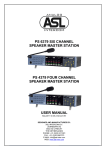Download ASL INTERCOM PS 279 User manual
Transcript
PS 279 DUAL CHANNEL MASTER STATION USER MANUAL October 2013 This product is designed and manufactured by: ASL Intercom B.V. Zonnebaan 42 3542 EG Utrecht The Netherlands Phone: +31 (0)30 2411901 Fax: + 31 (0)30 2667373 E-mail: [email protected] Web: www.asl-inter.com CONTENT OF THIS USER MANUAL 1.0 SAFETY INSTRUCTIONS........................................................................ 3 2.0 GENERAL DESCRIPTION PS 279 .......................................................... 4 3.0 MAINS POWER........................................................................................ 4 4.0 MECHANICAL INSTALLATION................................................................ 5 5.0 FRONT PANEL CONTROLS AND CONNECTOR ................................... 5 6.0 REAR PANEL CONTROLS AND CONNECTORS ................................... 6 7.0 INTERNAL CONTROLS ............................................................................ 7 8.0 TECHNICAL SPECIFICATIONS ............................................................... 7 9.0 PARTY LINE, TECHNICAL CONCEPT ..................................................... 8 10.0 CABLING.................................................................................................. 8 11.0 EARTHING CONCEPT ............................................................................ 9 12.0 PS 279 BLOCK DIAGRAM ....................................................................... 9 13.0 POSSIBLE SYSTEM CONFIGURATION ............................................... 10 PAGE 2 User Manual PS 279 / October 2013 © ASL Intercom BV 1.0 SAFETY INSTRUCTIONS Please always follow these instructions to help ensure against injury to yourself and/or damage to the system 1) Read all safety and operating instructions before you operate the apparatus. 2) Retain all safety and operating instructions for future reference. 3) Heed all warnings on the apparatus and in the safety and operating instructions and follow all instructions for installation, operating and use. 4) Unplug the apparatus from the AC power outlet before cleaning. Use only a damp cloth for cleaning the exterior of the apparatus. 5) Do not use accessories or attachments not recommended by the manufacturer, as they may cause hazards and void the warranty. 6) Do not operate this apparatus in high humidity areas or expose it to water or moisture. 7) Do not place the apparatus on an unstable cart, stand, tripod, bracket or table. The apparatus may fall, causing serious personal injury and damage to the apparatus. 8) Do not block or cover any openings in the apparatus. These are provided for ventilation and protection from overheating. Never place the apparatus near any heat sources such as radiators, heat registers, stoves, or other apparatus (including amplifiers) that produce heat. Do not place the apparatus in an enclosure such as a cabinet without proper ventilation. 9) Operate the apparatus using only the type of power source indicated on the marking label. Unplug the apparatus’ power cord by gripping the power plug, not the cord. 10) Insert the plug properly. Do not defeat the safety purpose of the polarized or grounding type plug. A polarized AC line plug has two blades with one wider than the other. This plug will fit into the power outlet only one way. This is a safety feature. f you are unable to insert the plug fully into the outlet, try reversing the plug. If the plug still fails to fit, contact an electrician to replace the obsolete outlet. A grounding type plug has two blades and a third grounding prong. The wide blade or the third prong are provided for your safety. If the provided plug does not fit into your outlet, consult an electrician to replace the obsolete outlet. 11) Route power supply cords so that they are not likely to be walked on or pinched by items placed upon or against them. Pay particular attention to cords at plugs, convenience receptacles, and the point where they exit from the apparatus. 12) Do not overload wall outlets or extension cords, as this can result in a risk of fire or electrical shock. 13) Unplug this apparatus during lightning storms or when unused for long periods of time. 14) Never insert objects of any kind into the apparatus through openings, as the objects may touch dangerous voltage points or short out parts. This could cause fire or electrical shock. 15) Refer all servicing to qualified service personnel. Servicing is required when the apparatus has been damaged in any way, such as when the power-supply cord or plug is damaged, liquid has been spilled or objects have fallen into the apparatus, the apparatus has been exposed to rain or moisture, does not operate normally, or has been dropped. PAGE 3 User Manual PS 279 / October 2013 © ASL Intercom BV 2.0 GENERAL DESCRIPTION PS 279 The PS 279 (19”/1RU) is designed to be a dual channel master unit in an ASL intercom system. To connect the unit to its remote stations, use microphone cable with 2 wires and 1 shield. Each channel has a Volume (listen level) control, a TALK and a CALL button with LED indicators and a side tone trimmer. The intercom line power supply is fully protected and can safely drive up to 20 Pro Series beltpacks or 10 remote 2-ch speaker stations operating at full power. In case the number of user stations exceeds the capacity of the PS 279 power supply, the PS 285 booster power supply can be used. Since the power supply provides the line impedance, one uses only one PS 279 in a 2channel system. Should the PS 279 be connected to another Intercom system, the ‘System link’ connector at the rear of the unit has to be used to avoid impedance problems. Special attention has been paid to the intelligibility of speech. By applying low noise/high speed opamps, a speech presence filter and a proprietary headphone amplifier, communication is very comfortable even in environments with a high background noise level. 3.0 The unique CALL system provides both a flashing red LED and a very distinctive and characteristic sound signal. Only a short push of the CALL button will make the LED flash. The Call sound signal (buzzer) is activated by holding the button for two seconds. In case the sound signal is undesirable, all buzzers can be muted with the “All buzzers on/off” button. Fully electronic switching allows for “soft” microphone on switching (latched or momentary) and remote Mic Mute facility. All microphones of stations connected to the PS 279 can be muted by pushing a single button on the front panel. An Aux input at the rear panel allows inserting external audio signals at line level. The Aux signal can be routed to intercom line A and/or B, or directly to the local headset. As an option, an XLR-6 headset connector can be fitted, allowing to hear channel A + AUX program signal on the left headset can and channel B + AUX program signal on the right headset can (“binaural use”). By changing the position of internally mounted jumpers, it’s also possible to hear channel A + B on the left can and the AUX program signal on the right can. MAINS POWER & SAFETY EARTH WARNING: This appliance must be earthed The PS 279 may be connected to a mains power outlet of 100 - 240 V AC (50 - 60 Hz), 100 watts. The outlet should have a clean earth. Avoid using mains power outlets which also power dimmer controlled lighting equipment. The wires in the mains lead are color coded: Green/yellow: safety ground Blue: neutral Brown: live In case the colors of the wires in the mains lead do not correspond with the colored markings of the terminals in your plug, proceed as follows: • The wire that is colored green-and-yellow must be connected to the terminal in the plug, which is marked with the letter “E”, or by the ground symbol, or is colored green. • The wire that is colored blue must be connected to the terminal that is marked with the letter “N” or colored black. • The wire that is colored brown must be connected to the terminal marked with the letter “L” or is colored red. For personal safety and for proper functioning of the PS 279 and connected stations the green-andyellow wire of the mains cord must always be connected to the electrical installation safety earth or ground. This wire is internally connected to all exposed metal surfaces. Any rack framework into which this unit might be mounted shall be connected to the same grounding circuit. The PS 279 employs professionally designed input and output circuits which do not require the disconnection the safety earth to avoid hum loops. Powering up procedure: • Make sure that the red power switch on the left side of the front panel is OFF. • Connect the power cord to the rear of the station. • Plug the other end of the power cord into a PROPERLY GROUNDED outlet. • Turn on the power with the red button. The red overload LED will light up for about 3 seconds, then extinguishes and the green power LED will switch on, indicating the station is active. PAGE 4 User Manual PS 279 / October 2013 © ASL Intercom BV 4.0 MECHANICAL INSTALLATION A vertical rack space of 1U (1.75” / 44,5 mm) is required for the PS 279. It is not necessary to provide rear support by extra bracing or shelving. Adequate ventilation must be provided by allowing sufficient space around the sides and rear of the nit to ensure free circulation of air. 5.0 Forced cooling is not required. The power supply is mounted on the bottom of the PS 279. After a period of time it will feel hot to the touch on top and bottom. This is normal and should be no cause for alarm. FRONT PANEL CONTROLS AND CONNECTOR 1 OVERLOAD LED This LED illuminates if the circuit breaker shuts off line power due to overload. A cause for overload can be too many user stations connected or a short circuit in the interconnecting cables. The circuit breaker resets automatically 3 seconds after the cause of the overload has been removed and restores the line power. During short circuit, the LED flashes every 3 seconds. Every time mains power is switched on, the LED is lit for a few seconds. 2 POWER LED This LED illuminates if line power is supplied by the internal power supply. 3 SYSTEM LINK LED / CHANNEL A This LED illuminates if a channel of another ASL Intercom System has been connected to channel A of the PS 279, through its “System Link” connector. The Line Impedance is now provided by the other Intercom system and the internal line impedance for Channel A is switched off. A Mic Mute signal sent from the other intercom system is also received by the user stations on Channel A. But a Mic Mute signal sent from the PS 279 is only received by the user stations on its own channels (it does not mute the microphones of the user stations of the other system). Buzzer Mute signals are not going from the other intercom system to the PS 279, nor in the opposite direction. See #8 for “Mic Mute” and #9 for “Buzzer Mute”. 4 SYSTEM LINK LED / CHANNEL B Same as #3, but for channel B. 5 POWER ON/OFF switch To switch the internal power supply ON and OFF. 6 BUZZER VOLUME trimmer To adjust the buzzer volume. 7 BUZZER Indicates an incoming or outgoing call. It is activated by pushing a CALL button of the PS 279 or a CALL button on any other station on channel A or B for longer than two seconds, provided the buzzers are not muted (see #9). The buzzer volume may be adjusted with the buzzer volume control (see #6). 8 ALL MIC’S ON/OFF button With this push button all microphones of the connected stations can be switched off. Each user station can activate its microphone again by pushing its TALK button. 9 ALL BUZZERS ON/OFF button With this push button all buzzers of the connected user stations can be muted. The buzzers remain muted until the Mute button is switched off again. 10 AUX VOLUME controls These knobs adjust the level of the Aux input signal to each of the two intercom lines. 11 A / B / HEADSET routing switches These three switches route the Aux signal to either (1) Intercom channel A and/or Intercom channel B or (2) directly to the headset and not to the intercom channels. 12 VOLUME control knobs To adjust the listen level of the headset, for each channel separately PAGE 5 User Manual PS 279 / October 2013 © ASL Intercom BV 13 SIDE TONE trimmers To adjust the level of one’s own voice as heard in one’s headset. Adjustment procedure: • set the trimmer in start position: fully clockwise • switch off the microphone of all connected (speaker) stations • switch on the microphone of the required channel • turn up the volume of the required channel • speak into the headset microphone • adjust the listen level by turning the side tone trimmer The operating area is between fully clockwise and minimum level. Adjusting the side tone does not affect the level of your voice as it is heard by other user stations. 15 CALL buttons A & B To activate the CALL system. A momentary push sends a visual Call signal to all stations connected to the referring intercom channel and the Call LEDs start flashing. If holding the buttons pushed for 2 seconds, the buzzers are activated. After the CALL button is released the LEDs continue to flash for a further 2 seconds. 14 TALK buttons A & B These buttons allow talking to each channel separately or both channels simultaneously. If a Talk button is activated, its green LED is lit. Pin assignments: Pin1: shield mic. (GND) Pin 2: mic. + Pin 3: phones + Pin 4: phones – Latched switching: If a TALK button is pushed shortly it is electronically latched and the microphone signal is sent to the referring channel. If the button is pushed again, the connection between microphone and the channel is cut off. Momentary switching: If a TALK button pushed and held, the microphone signal is sent to the referring channel until the button is released. 6.0 16 HEADSET connector (XLR-4) To connect the headset to the PS 279. The headset can must have a minimum impedance of 200 ohms. In case the headset has to cans in parallel, each can must have a minimum impedance of 400 ohms. The headset microphone may be of the dynamic or electret type. In case of 2 headset cans the wiring is such that both cans receive the same signal. The two headphone amplifiers run in a bridged mode. As an option, an XLR-6 type connector can be fitted to allow a binaural headset configuration where a different signal will appear on each can. (See also section 7). In this mode the internal headphone amplifiers are not bridged. . REAR PANEL CONTROLS AND CONNECTORS 17 DC INPUT connectors These connectors accept 24 – 30 V DC as a (backup) power source should mains power not be available or fail. 18 SYSTEM LINK IN connector Input for the cable of an external party-line Intercom system. If a channel of the PS 279 is to be connected to another intercom system then this connector accepts the communication signals from the other system. See also #4 and #5. PAGE 6 User Manual PS 279 / October 2013 © ASL Intercom BV 19 A & B LINE connectors These XLR-3 connectors are for connecting the PS 279 to remote stations via the intercom party lines. There are 2 connectors for each channel. Pin assignment: Pin 1: 0V / ground shield Pin 2: +30V power. Pin 3: audio wire 20 GROUND LIFT switch If in “lift” position pin 1 of the AUX input XLR is lifted from ground. 21 AUX INPUT connector Electronically balanced input for line level audio signals. Pin assignment: Pin1: 0 V / ground Pin 2: signal (+), Pin 3: signal ( -) 7.0 22 MAINS INLET IEC Mains connector 23 FUSE This fuse protects the PS 279 against severe internal damage in case of malfunction in the power section. Spare fuses are supplied with the unit. Before replacing the fuse the mains cord must be removed. Make sure that the correct fuse (T 1250) is placed in the holder. INTERNAL CONTROLS Mic Gain trimmer To reach the mic gain trimmer, undo the two screws at the front panel and the two screws on the top side. The trimmer is located at the right front of the unit. To increase mic gain turn counter clockwise. To decrease mic gain turn clockwise. Binaural Jumper Settings For binaural use of the PS 279, the unit must have an XLR-6 headset connector. The binaural configuration is set as follows: Jumpers J3 in position A: Left can: Channel A and B Right can: AUX signal Jumpers J3 in position B: Left can: Channel A and AUX signal Right can: Channel B and AUX signal 8.0 TECHNICAL SPECIFICATIONS System Dynamic range: 80 dB Frequency response: 200 Hz – 15 kHz (-3 dB) Call send signal: +2.8 mA Call receive signal threshold: +2.4V DC Operation voltage: 24 - 32 V DC Power interrupt time (mic mute): 0.1 sec. Line Impedance: 350 Ω (1 kHz) / 2.2 kΩ (DC) Audio level: nom.-18 dBu, max. 0 dBu Headphone Driver Amps Max. output level: monaural: 16 Vrms (@ 200 Ω binaural: 2 x 10.3 Vrms (@ 400 Ω Max. output power: monaural: 1.3 Wrms (@ 200 Ω binaural: 2 x 0.27 Wrms (@ 400 Ω Side Tone Rejection: 0 - 30 dB adjustable Switch Mode Power Supply Mains voltage: 100 - 240V AC, 50/60Hz Output voltage: +30V DC (+/- 5%) Max. output power: 75 Watts Circuit breaker delay time: 0.2 sec. Automatic reset time: 3.0 sec. Buzzer: Max. SPL: 85 dBA DC Input Supply voltage: 24 – 30 V DC Dimensions & Weight Width: 19" (483 mm) / Height: 1RU (44,5 mm) Depth: 150 mm / Weight: 1.85 kg Mic. Pre-amp Gain: 40 - 60 dB (adjustable internally) Presence filter: +6 dB at 5 kHz Power to electret mic.: +9 V DC Aux input (Line level) Input impedance: 39 kΩ Nominal input level: 0 dBu Max. input level: +21 dBu 0 dBu defined as 775 mV into open circuit ASL reserves the right to alter specifications without prior notice PAGE 7 User Manual PS 279 / October 2013 © ASL Intercom BV 9.0 PARTY LINE, TECHNICAL CONCEPT User stations in an ASL intercom system are connected via one or several 'party lines'. A party line offers two way (‘full duplex’) communication and consists of standard microphone (multi-pair) cable. One wire is used as an audio line, one as a power line and the screen of the cable functions as earth/return. Current drive is used for signal transfer. Each station utilizes a current amplifier to amplify the microphone signal and place it on the common audio line where, due to the constant line impedance (situated in the power supply between XLR pin 3 and 1), a signal voltage is developed which can be further amplified and sent to the headphones or loudspeakers. 10.0 This principle has three advantages: • the use of a single audio line allows several stations to talk and listen simultaneously • due to the high bridging impedance offered by each station, the number of stations on the party line has no influence on the level of the communications signal • power and audio to the intercom stations use the same cable The Call signal is also sent as a current on the audio line. It develops a DC potential over the line impedance which will be sensed by each station and interpreted as a Call signal. CABLING The intercom lines (the ‘party lines’) are of the shielded two-conductor microphone cable type. The intercom line connectors are of the XLR-3 type. Audio and Call signals are on XLR pin 3, DC power is on XLR pin 2. XLR pin 1 is connected to the shield of the cable which functions as the common return for audio and power. The audio signal is transferred in an unbalanced way (see ‘Party Line, Technical Concept’). To avoid earth loops (hum), the possible effect of electromagnetic fields and to minimize power loss, certain rules have to be obeyed when installing the cabling of an intercom system : Use high quality cable Use high quality microphone cable (shielded two conductor cable, minimum 2x 0.30 mm2). In case multi-pair microphone cable is used, it should be of high quality and each pair should consist of two conductors (minimum 2x 0.15 mm2) with separate shield and an overall shield. Use flexible cable Use flexible single and multi-pair microphone cable instead of cable with solid cores, especially when the cable is subjected to bending during operation or installation. Cable screens to XLR pin 1 The screen of each separate microphone cable and/or the screen of each single pair in a multi-pair cable, should be connected to pin 1 of each XLR-3 connector. Do not connect these screens to the metal housing of ASL unitst or XLR-3 wall boxes. See section ‘Earthing Concept’. Connect metal cable trunks, wall boxes and overall multi-pair cable screens to clean earth Metal cable trunks, metal wall boxes and overall multipair cable screens should be interconnected and, at the 'central earth point' in the intercom network only, be connected to a clean earth or a safety earth. See section ‘Earthing Concept’. Keep metal connection boxes and cable trunks or pipes isolated from other metal parts Metal trunks or pipes for intercom cables and metal connection boxes should be mounted in such a way that they are isolated from any other metal housing or construction part. Keep cables parallel as much as possible When two (multi channel) units in a network are connected by more than one cable, make sure that these cables are parallel to each other over the whole distance between those units. When using multi-pair cable, parallelism is ensured in the best possible way. Avoid closed loops Always avoid that intercom cables are making a closed loop. So-called 'ring intercom' should not physically be cabled as a ring.. Keep cables away from electromagnetic sources Keep intercom cables away from high energy cables, e.g. 115/230/400V mains power or dimmer controlled feeds for spotlights. Intercom cables should cross high energy cables at an angle of 90º only. Intercom cables should never be in the same trunks as energy cables. Place power supply in a central position In case of a system powered by a separate power supply: In order to diminish power losses, place the power supply as close as possible to where most power consumption occurs, in other words most user stations are placed. ASL powered units to a 'clean' mains outlet Master stations or power supplies should be connected to a mains outlet with a clean earth. Other audio equipment may be connected to this mains outlet, but avoid using an outlet which also powers dimmer controlled lighting systems. PAGE 8 User Manual PS 279 / October 2013 © ASL Intercom BV 11.0 EARTHING CONCEPT 12.0 PS 279 BLOCK DIAGRAM PAGE 9 User Manual PS 279 / October 2013 © ASL Intercom BV 13.0 POSSIBLE SYSTEM CONFIGURATION PAGE 10 User Manual PS 279 / October 2013 © ASL Intercom BV










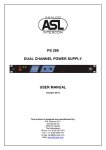
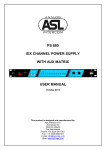



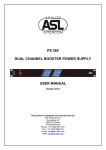
![User Manual PS 260 [ASL]](http://vs1.manualzilla.com/store/data/005875222_1-79f7ffd37f8e6cc3732f57605cc0b82b-150x150.png)
![User Manual PS 260 [ASL]](http://vs1.manualzilla.com/store/data/006916739_1-983cb380987130e2fe2cf762515f3398-150x150.png)
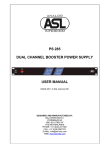
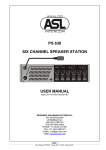
![User Manual PS 260 [ASL]](http://vs1.manualzilla.com/store/data/005887031_1-132c7eb8ac96774a27528798f7f3ad09-150x150.png)

